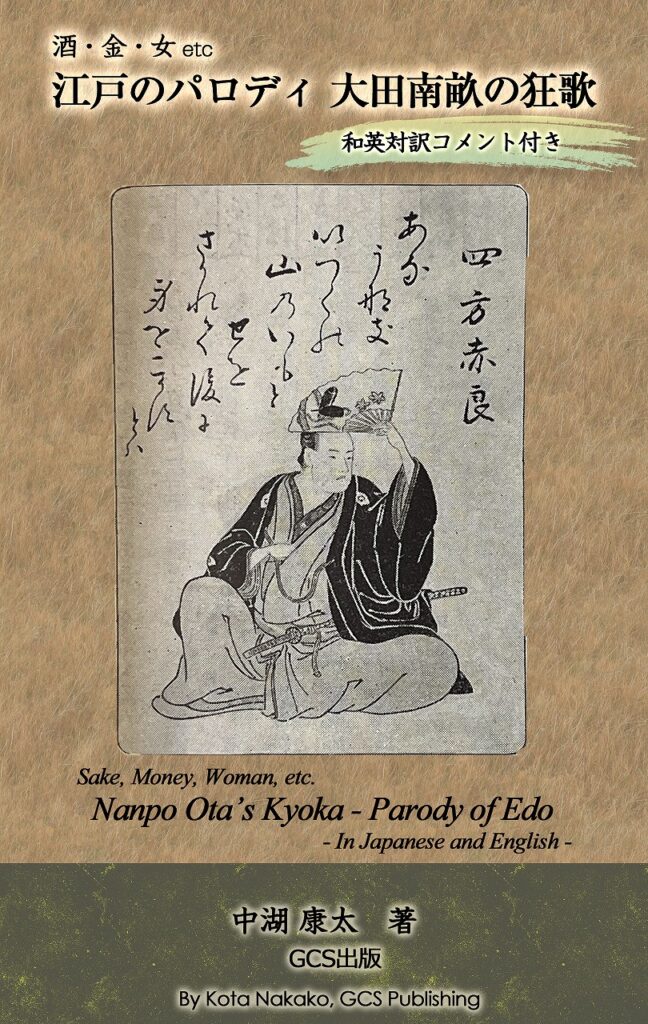新著「江戸のパロディ 大田南畝の狂歌 Nanpo Ota’s Kyoka – Parody of Edo」
酒・金・女etc. 江戸のパロディ 大田南畝の狂歌 Nanpo Ota’s Kyoka – Parody of Edo: 和英対訳コメント付き in Japanese and English (GCS出版)
笑いは人の心をリフレッシュするものです。笑いは、自由な心の表れ、発散であるといってよいでしょう。もっとも笑いといっても、単純な滑稽から、ウィット、ユーモア、ジョーク、パロディ、ギャグ、風刺、皮肉など多様です(厳密な定義はさておき)。
日本においても、江戸時代に笑い、諧謔の文学が、日本人のこころに響く、五・七・五・七・七の和歌の形式を借りて狂歌という形で花開きました。それが、いわゆる江戸狂歌です。これを主導したのが幕臣で下級武士、知識人たる大田南畝(歌号:四方赤良、蜀山人)です。
江戸狂歌が隆盛した背景には、田沼時代の民間の経済活動を活発化させる、当時としては開放的な政策があります(一方で賄賂が横行したとの批判もありますが)。
江戸時代に、単純な滑稽を超えた、パロディ、ギャグ、ユーモア、風刺を含む、笑いの文学の隆盛をみたのは興味深いことです。しかし、この笑いの文学も、田沼に続く、統制的、緊縮的な寛政改革によりしぼんでゆき、南畝も筆を折ります。笑い、諧謔が、自由でオープンな社会の雰囲気と密接な関連を持つことを示唆しています。
本書は、大田南畝の代表的な122首を英訳し、酒、金、女など9つのテーマに分類、和英対訳でコメントを付したものです。執筆の目的は、①江戸狂歌を、国内のみならず世界の人々に知ってもらうこと、②現代の日本人にとっても必ずしもやさしいといえない江戸狂歌を、英語への翻訳、コメントを通して、意味を明確化し、身近なものにすることです。
本書が、大田南畝、江戸狂歌、そして広く日本文化に興味ある多くの人々の参考になれば誠に幸いです。
2024年5月
中湖 康太
Preface
Laughter refreshes and releases our mind and body. However, there are many kinds of laugher; e.g. induced by exaggeration, lark, prank, comic, wit, humor, parody, gag, satire, irony, etc. save the exact definitions, here.
It is notable that Kyoka, or comic tanka, flourished in Japan in Edo period, making use of traditional 31 (5-7-5-7-7) syllables, which naturally resonates in Japanese mind. The rise of Kyoka was led by Nanpo Ota (pen names: Akara Yomo, Shokusan-jin), a shogunate vassal, an intellectual and then the greatest Kyoka author.
Behind the surge lied the open policy of ‘Tanuma Period’, placing emphasis on the activities of the private sector, albeit criticized as bribery-prone.
It declined in the following Kansei Reform, austere and restrained. Nanpo broke off writing, accordingly. It suggests that laughter, humor, joke and the like, are closely linked to the atmosphere of free and open society.
This book includes Nanpo’s 122 representative Kyoka poems, divided into 9 topics such as sake, money, woman, etc., with explanatory comments both in English and Japanese. There are two aims for writing this book. First is to make Nanpo’s Kyoka more accessible to people outside Japan or non-Japanese. Second is to do so even to many Japanese, as Japanese language in Edo period is not necessarily easy to understand for them today.
It is my great pleasure if this book is useful to many people who are interested in Nanpo Ota, Edo Kyoka and more broadly Japanese culture.
May 2024
Kota Nakako















